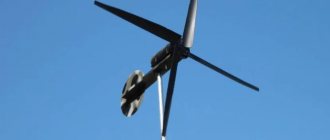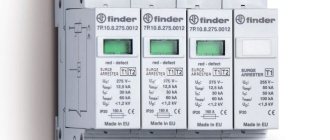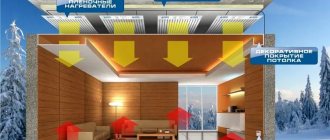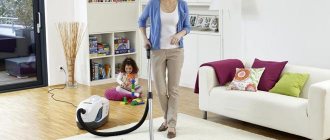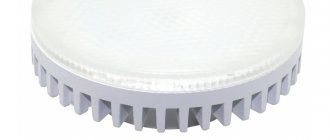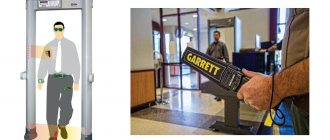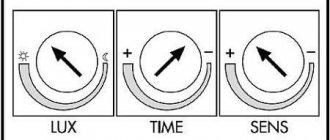| Place | Name | Characteristics in the rating |
| TOP 5 best wind generators from AliExpress |
| 1 | Smaraad | The best ratio of price and quality |
| 2 | Becornce | The most popular wind generator on AliExpress |
| 3 | VESDAS | Best price |
| 4 | JSRX ZXX | Stainless steel blades |
| 5 | FLTXNY | The most reliable device |
A wind generator is a great opportunity to use natural energy, for which you don’t have to pay. By installing such a unit in a private home, you will provide it with a supply of electricity sufficient to ensure the operation of basic systems.
It is worth noting that our rating does not consider huge generators that produce several hundred kilowatts, but small devices that are easy to install with your own hands. Their power rarely exceeds 800 W, and this is quite enough to operate devices from 12 or 24 volts. The AliExpress platform offers many interesting models that differ in a number of factors:
- size;
- installation method;
- output power;
- regulation of incoming and outgoing energy;
- availability of additional functions.
Our top list included devices with excess power up to a kilowatt, delivering 12 or 24 volts, since they do not require registration, are not taxed, and also have an optimal level of noise pollution. Such a wind generator does not need to be installed at a great distance from the home, and even a person who is only superficially familiar with electronics can handle its connection.
General turbine performance
The main parameter that interests the consumer in the first place is the power of the device. This is an indicator of the efficiency of a windmill, allowing you to evaluate the cost of the energy received and decide how much such a device solves the existing problem.
The second, no less important and significant indicator is the price of the wind generator . Too expensive samples are not available to ordinary users, so their production is irrational from an economic point of view.
In addition, maintainability , operating and maintenance features of the device are taken into account. These issues are to some extent even more important than the price, since the purchase is made once, and maintenance and repairs can be made quite often, requiring ongoing costs.
It must be taken into account that a wind generator is a complex consisting of a fairly large number of components. The performance of the entire system depends on the individual parameters of the elements; a single weak node can reduce the performance of the entire complex, therefore, among the important parameters should be the complete compliance and compatibility of all nodes and elements with each other.
How to solve the payback problem
A question of questions. It was, is and will be the most popular and relevant. Especially for residents of central Russia, where the winds are not so strong. Under such conditions, how can you choose the optimal wind generator so as not to burn out and quickly recoup its cost?
There are two ways to solve the problem:
- Reducing to a minimum all costs during the operation of a wind power plant;
- And increasing its productivity.
The first way out has been found and it is offensively simple, like a steamed turnip. Experts advise that instead of one powerful wind generator, install several small wind turbines, which begin to work at the weakest breeze, since they have light and pliable blades. Small installations do not require large foundations to be poured with concrete and are installed by several workers rather than teams of specialists using various equipment.
And the second way to solve the problem is to install vertical wind generators instead of horizontal ones. They are most sensitive to the “breathing” of winds, do not require special care during operation and are ready to work at a low altitude from the surface.
We count. With an average annual speed of air mass movement in central Russia of 4 m/sec, an industrial horizontal windmill with a rated power of 10 kilowatts will produce about 800 kW/hour per month. In order to match it, you will need seven small household vertical windmills, which are unpretentious in operation and easy to install.
How much power can you get from them? According to actual observations and calculations, each produces approximately 20-40 watts per square meter of windmill. That is, it is possible to firmly count on receiving a stable power of 140 - 280 watts. This means that there is not enough power for energy-intensive appliances and consumers, such as an electric stove, a sauna. But it is quite capable of charging the battery, powering the TV, computer, and lighting. And with proper storage and accumulation of energy, you can run the water pump and heat the house.
So, the use of wind mini-power plants in central Russia is quite legal and economically profitable.
V. Ilyin
In the following video, experts discuss the cost and prospects of using wind generators:
Review of the best brands and installations
The Russian market of wind generators offers both reliable, relatively inexpensive devices from domestic brands, and models of wind turbines from foreign manufacturers that vary in functionality. To decide on the choice of installation for your home, you need to compare the characteristics of different units.
No. 1 - wind generators Condor Home (Russia)
A series of wind turbines for home use includes devices with a power of 0.5-5 kW. They can serve as the main source of electricity or additional. Condor Home stations are adapted for operation in low temperature conditions and are capable of producing energy even in low winds.
Depending on the model, the generator housing is made of plastic or cast aluminum, the blades are made of fiberglass. There is an effective dual braking system. The mast is composite, on guy wires, and has a height of 8-12 m. To install these units, you need a pile or concrete foundation.
Condor Home home wind generators are completely ready-made products that do not require special knowledge or technical skills to operate. The devices are designed for electrification of both free-standing buildings and small settlements as part of wind power plants
The basic package includes a mast and guy ropes, a generator, a rotor and blades, a charge controller, and fasteners.
No. 2 - Falcon Euro mini-power plants (Russia)
They are high-tech vertical-axis wind generators with a power of 1-15 kW. They are used for primary/backup power supply to consumers remote from power lines. Can be used as part of a complex with solar panels and a fuel generator.
Windmills are equipped with powerful neodymium magnets. The starting wind speed for starting the installation is 1.5 m/s, the nominal speed is 11 m/s. The installed aerodynamic brake helps limit wheel speed. The declared service life from the manufacturer is 20 years, the factory warranty on the mini-power plant is 36 months.
Falcon Euro wind generators are reliable in operation and unpretentious in maintenance. With the help of devices of this series it is easy to solve the problems of power supply of local and island facilities
The basic Falcon Euro installation kit includes several functional elements: a wind wheel, a generator and controller, a mast, and embedded parts. The inverter installation and batteries are selected separately.
No. 3 - wind turbines Sokol Air Vertical (Russia)
Small wind power plants of this brand can provide electricity to both small cottages and medium-sized enterprises. For domestic use, SAV devices with a power of 0.5-15 kW are produced.
They are characterized by high efficiency in light winds, operate smoothly at low and high temperatures in the range from -50 °C to +50 °C, are characterized by low noise levels and resistance to external influences.
The generation of electricity by Sokol Air Vertical units does not depend on wind direction. Vertical-axial installations operate in automatic mode without maintenance personnel. The design provides an electromagnetic and aerodynamic braking system to limit the speed of the wind wheel.
The blades are made of reinforced polyester or aircraft grade aluminum (depending on the model) and have a self-unwinding profile. The generator is a multi-pole three-phase generator with excitation from permanent magnets.
Sokol Air Vertical wind turbines produce rated power at 7-8 m/s, which allows their use in regions with low average annual wind speeds
The basic package of a wind power plant includes: a wind turbine with a battery charge controller, a mast with guys, and an installation kit. The inverter and batteries are selected separately according to the technical specifications.
No. 4 - wind generators Energy Wind (Russia)
Buyers have access to single- and three-blade models of universal-use products with a power of 1-10 kW. These wind turbines are perfect for creating projects to provide electricity to private residential buildings and cottages.
Energy Wind units are based on durable blades made of reinforced fiberglass, painted with auto enamel, and a reliable air flow exhaust system. These units with a horizontal axis of rotation operate stably at temperatures from -40 to +40 degrees Celsius.
The minimum operating wind speed is 2 m/s, at some blade positions - 3 m/s, the recommended mast height is 8-20 m. The average service life of Russian brand installations is 25 years, the official warranty from the manufacturer is 3 years.
Energy Wind wind generators do not require constant care or maintenance, which contributes to the rapid reinvestment of invested funds
The basic equipment of the installations includes a permanent magnet electric generator with a mounting unit for the mast and a rotating mechanism, blades, and a set of fasteners for assembling a wind turbine. The mast, as well as the controller, inverter and batteries for storing electricity must be purchased separately.
No. 5 - Altek EW wind turbines (China)
Type of wind turbines – with a horizontal axis of rotation. Devices with a rated power from 1 kW to 10 kW are ideal for solving the problems of power supply to country houses and cottages.
The protective casing of Altek EW wind turbines is made of aluminum alloy, which significantly facilitates the design. The functional metal parts of the generator are coated with silicon for heat resistance.
The blades are made of fiber-reinforced plastic. The starting wind speed for launching household units of the Chinese brand is 2.5 m/s, the nominal speed is 12 m/s.
Altek EW wind generators are one of the most affordable devices for generating electricity that are presented on the modern alternative energy market
The basic package includes blades, a generator and a controller. The remaining functional elements for the windmill must be purchased.
If the cost of a factory-made kit seems too high to you, it makes sense to build a wind generator with your own hands. The article we recommend describes how to make a useful household appliance from a washing machine.
Comments:
Uncle Vova
I assembled a vertical windmill from an oil drum, it worked until winter. The bearings in the generator are covered because... In the spring, it only produced creaking and grinding noises, but no electricity. You need very good bearings.
Evgen
I’ve been hooked up to a regular Zhiguli generator and it’s been working fine for three years now. It illuminates the street, and in the summer I connect a mole repeller to it. It seems to me that the problem is not in the bearings, but in the tightness.
Bogdan
Evgen, of course, the problem is tightness, but if you install seals that will not allow moisture to pass into the bearing, the efficiency of the entire structure will decrease. So I’m thinking, what should I do? Should I leave everything open or seal it as much as possible?
Igor
People, what are you talking about? Do you want to protect your car generator with something else? Yes, it is designed to work in such extreme conditions that a windmill (even one made from a barrel) is a vacation for it! There is always water, dirt and snow under the hood and the temperatures are the most extreme. The fact that Uncle Vova’s bearings broke on his auto-generator means that they had been broken for a long time, and were waiting for the “right moment” to announce it.
Vladimir
Bearings must be taken from 18 GPP, or from France, Sweden. I think SKF bearings with original lubrication (hub) have been working for 12 years, and there is zero noise.
Madi
The most advanced vertical-axis wind generator https://www.facebook.com/madiz.zhakypov/posts/10154799110278007
Virtual Private Server
That is, it turns out that people are simply being deceived by saying that vertical wind generators are more efficient in low winds. There are also Daria rotors, they are faster and larger than KIEV, but they have problems with starting in low winds and uneven thrust, and their calculation is very complicated.
Michael
One thing is clear: the windmill must be installed in “batteries” of three to six... pieces. Then it will make sense. At least heat the water.
Leave a comment Cancel reply
Related Posts
Is it profitable to buy a set of solar panels for a summer residence? Types of controllers for solar panels and how to choose
The principle of operation of solar panels.
Solar panels for a private home: put light to your service
10kw 380v 50hz, China Supplier
Specifications of 10kw household wind generator
household wind stable, safe, low noise good power installation easy CE / ISO certified
As a manufacturer of small wind turbines for more than 6 years, we offer you:
Stable products
Practical solutions
Competitive price
Best after sales service
Welcome to us, we are ready to offer what is available.
| Model | NE-3k | NE-5k | NE-10k |
| Rated power | 3kw | 5kw | 10kw |
| Maximun power | 4kw | 6kw | 13kw |
| Rated voltage | 96 / 120 / 220V | 120 / 220 / 240v | 220 / 240 / 380v |
| Start up wind turbine | 3m/s | 3m/s | 3m/s |
| Rated wind speed | 10m/s | 10m/s | 10m/s |
| Survival wind turbine | 45m/s | 45m/s | 45m/s |
| Top net weight | 205kg | 285kg | 9 0002400kg |
| Wheel diameter | 5.6m | 6.3m | 8.2m |
| Number of blades | 3 | ||
| Blades material | Armored glass fiber | ||
| generator | Three phase AC permanent magnet synchronous generator | ||
| magnet | NdFeB | ||
| Generator case | Carbon steel | ||
| Control system | Electromagnet / wind wheel yaw | ||
| Speed regulation | Tail furling | ||
| Working temperature | -40°C – wind turbine 80°C | ||
| Design life | 20 y |
10kw household product Features
1.Carbon steel body, compact, safe
2.Reinforced fiberglass blade matching optimized aerodynamic shape and structures that improve wind energy efficiency and annual output.
3.Patented permanent magnet alternator with special stator, effectively reduce the torque, well match the wind wheel and generator, and ensure the performance of the whole system.
4.Tail adopts mechanical yaw technology, which makes it survive the storm and launch safely
5.With high zinc epoxy primer and polyurethane anti-corrosion treatment, can be UV proof, acid rain resistant, salt resistant
5KW wind turbine parameter
The feasibility of installing a wind generator
Small wind power plants are now widely used as alternative sources of electricity, which allow real savings to be achieved.
Such devices are usually installed in summer cottages, in areas remote from main power grids. But this is not the only reason why people increasingly prefer structures of this type.
Land owners successfully use wind generators to achieve complete autonomy and significant energy savings
However, not every area is suitable for installing a wind turbine. In order for the mini-power plant to fully function during the service life declared by the manufacturer, the climatic conditions of the area must meet the requirements of special equipment.
The average wind speed should not be less than 4.5-5 m/s. Only in this case will the installation of a structure with a wind turbine be economically justified.
To find out approximate data on the average annual wind speed by region, you need to view a special wind map. More accurate information can be obtained using an anemometer and a signal reading device.
The measuring system must be installed at a high altitude so that nearby buildings and trees do not distort the results.
If you decide to install a mini wind farm for your home, you should also think about the available space. At the same time, it is necessary to take into account that the wind must “walk” absolutely freely along the blades, and without obstacles in its path, reach them from different sides.
That is why the ideal place to install a wind turbine is considered to be the tops of hills, where air masses are compacted with a corresponding increase in pressure and wind speed. Marine regions and the steppe zone are also considered suitable.
To get the full benefit from a wind turbine, it must be installed in a place where there are no trees or tall buildings
Any obstacles within a radius of 250 m will affect the operation of the wind generator. To obtain maximum efficiency indicators, it is necessary to install the turbine axis above the level of obstacles by at least 4-5 m.
Equipment selection rules
The selection of a wind generator for your home should be approached responsibly.
You need to collect basic information in advance:
- Calculate the nominal and maximum amount of electricity to meet the needs of the house.
- View the average annual wind speed in your area to determine when your windmill will be idle.
- Take into account the climatic features of the area. If there are severe frosts in the winter season, installing a wind farm will not be worthwhile.
- Find out the intensity of noise created when wind generators operate.
- Compare the technical characteristics of devices from different manufacturers.
The selection of component functional elements for a wind power plant is carried out according to the nominal power value. In this case, the nominal wind speed also plays a role - the values at which the wind generator generates the calculated amount of electrical energy.
If the installation produces maximum power at a wind speed of 11 m/s, and in your area the average reaches 4.5 m/s, the windmill will not produce the amount of energy declared by the manufacturer
It is also necessary to focus on the fact that the power of a wind generator depends on the diameter of the wheel formed by the blades. If the size is doubled, the windmill will produce 4 times more electricity at the same wind speed.
The capacity of the batteries is also important. If there is no wind, they should have enough energy to power the house.
It is better to entrust the installation of a private mini-wind power plant to a company that specializes in performing this type of work. The main goal is to ensure maximum safety. The overall design of the wind turbine must be guaranteed to remain stable even in extreme weather conditions
Low-power models of wind generators with light, low masts can be installed independently. The central support must be mounted on a reinforced concrete foundation. For lateral stability of the structure, 3-4 stretch marks are used.
Approximate prices and payback of wind generators
The popularity of wind turbines is growing every day. They are beneficial for equipping large and expensive cottages, the maintenance of which requires a lot of electrical energy.
It is advisable to install wind turbines in populated areas where there is no centralized power supply or the power supply is constantly interrupted.
It is in such cases that wind generators will come to the rescue, the use of which has a number of advantages:
- transformation of air flow energy into free electricity;
- environmental safety of wind turbines;
- absence of raw materials and waste in electricity production;
- minimal wear of functional parts;
- long service life - 25-30 years;
- there is no need to constantly monitor the operation of the wind farm.
Disadvantages include variability and unpredictability of wind strength. To minimize losses, you need to duplicate the source or install an additional buffer for energy storage. Also, a rotating wind wheel poses a potential threat to flying birds.
Wind power plants create noise comparable to the noise of vehicles when driving at a speed of about 70 km/h. Increased noise levels not only scare away animals, but also cause discomfort to people
Another significant disadvantage of wind turbines for domestic use is their high cost. These bulky structures are made of expensive materials and include a controller, batteries, an inverter installation and a mast.
It should be noted that household wind generators from Russian manufacturers, as well as high-quality wind turbines produced in China, are much cheaper than their European counterparts. The cost of domestic wind turbines with a vertical axis with a nominal power of up to 2 kW varies in the range of $1300-2500.
But at this price, the package only includes a generator with blades. The rest of the equipment will have to be purchased separately or made by yourself. Complete installations cost approximately 40-50% more.
The price of wind farms for home use with a power of 3 kW to 7 kW is much higher. Such generators with associated equipment will cost the buyer $5,000-$12,000.
Currently, the use of wind turbines as an alternative to centralized power supply is unprofitable due to the high cost of equipment
And even when there are interruptions in the supply of network electricity, it is not always advisable to install a wind generator. It will be easier and cheaper to install an uninterruptible power supply system based on industrial batteries in combination with a UPS.
It makes sense to install a wind power plant in places where access to a centralized energy supply is completely absent. The payback period in this case is 25 years.
Before purchasing components for assembling and installing a wind energy generator, it is advisable to carry out calculations using the formulas given in our recommended article. Here you will find the order and rules for performing calculations.
Installation features
It is better to invite specialists from engineering companies to install and connect the windmill. The cost of such services is no more than 10% of the total price of the wind turbine. But the quality and accuracy of installation are appropriate, because it is assumed that the wind turbine will operate for 2-3 decades.
Obstacles at a distance closer than 150 m should be 3-4 m below the installation point of the wind generator. The devices vibrate during operation, and the windmill mast is not allowed to touch the roof and walls of the building. If possible, it is better to move the windmill several meters (or even tens of meters) from the house.
If weak or medium winds prevail in an area throughout the year, it is necessary to increase not the number or capacity of battery packs, but the number of wind generators themselves. After all, even the most capacious batteries can be discharged in 3-4 days of calm.
Several wind turbines are connected to a single battery unit. During installation, it should be taken into account that the minimum distance between wind generators should be no more than one third of the height of the structure. Otherwise, the “neighbors” will use the “alien” wind.
Another rule is that the higher the mast, the greater the output of the wind turbine. This is due to the fact that at high altitudes the wind flow moves not only faster, but also more uniformly.
Often, to reduce installation costs, it is proposed to install wind turbines at a lower height.
But this saving is fictitious. So a higher mast will make it possible to significantly increase the efficiency of using wind turbines.
Support masts
The support mast not only holds the wind generator. The height of the mast determines how much electricity the wind turbine will produce. Typically, the higher the mast, the greater the wind speed. The quality of the support mast is also of great importance for the operation of the entire system.
In engineering calculations of the wind resistance of mast structures, the characteristics of the windiest regions of our planet were used.
We produce three main types: guyed tower, freestanding tower, hydraulic freestanding tower.
Hydraulic support mast technology is used in installation and maintenance to automatically raise and lower the wind turbines during installation and operation.
When using hydraulic equipment, a crane may not be required at all, installation and maintenance costs are greatly reduced. In addition, hydraulic equipment can be reused, which provides practical convenience and is more cost-effective.
Types of wind power plants
Based on the type of consumer, a distinction is made between autonomous wind generators and network-powered installations. The former supply energy to consumers remote from central electrical networks.
The second ones can number several tens/hundreds of wind turbines, which form a single system and supply energy to a common network. The power of autonomous units rarely exceeds 75 kW, while the power of network installations starts at 100 kW.
Depending on the type of construction, wind generators are distinguished:
- with a vertical axis of rotation;
- with horizontal axis of rotation.
These devices are used for different operating conditions, but the most common are models with a horizontal axis. They work like regular weather vanes and have a similar structure. The rotor axis rotates parallel to the earth's surface.
Such units are characterized by high efficiency (about 40%), simple power adjustment and a more affordable price, but are also characterized by high levels of noise and vibration generated. In addition, they must be oriented towards the direction of the wind.
To install a windmill with a horizontal rotor, you need approximately 120 m of free space and a mast with a height of at least 8 m
Wind generators with a vertical axis of rotation have a more compact design and are less susceptible to environmental factors.
In devices of this type, the turbine is located perpendicular to the plane of the Earth. Such structures are launched even from a weak wind and do not depend on the direction of air flow.
The low noise level (up to 30 dB) makes it possible to install vertical wind turbines on the roofs of buildings
However, there is also a significant disadvantage - the efficiency of such generators is only 15%. In addition, they are more expensive than horizontal axis models.
Models of wind generators differ from each other not only in the location of the rotational axis, but also:
- number of blades - there are windmills with two and three blades, and there are also multi-blade modifications;
- materials for manufacturing functional parts - with sail and rigid blades;
- screw pitch – adjustable or fixed.
Multi-blade stationary windmills begin to rotate even in low winds, but two- and three-blade devices require stronger winds to operate. At the same time, each additional blade in the design creates more resistance to the wheel, making it more difficult to achieve the generator's standard operating speed.
Depending on the material used to make the blades for a wind turbine, certain operational difficulties may arise. Sailing elements are easier to manufacture and therefore cost less.
But if it is necessary to ensure reliable operation of a wind turbine for autonomous power supply, it is worth giving preference to structures with rigid blades made of metal or reinforced fiberglass.
As for the propeller pitch, things are not so simple here either. The variable pitch allows you to significantly expand the range of effective speeds for operating a wind farm and this is a big plus. But at the same time, such a mechanism reduces the overall reliability of the stationary installation and significantly makes the wind wheel heavier, complicating the operation of the unit.
Biodegradable blades
The Achilles heel of the fast-growing wind energy industry is the physical components of wind turbines, which are made from petroleum resins and end up in landfills.
The more wind turbines there are, the more used blades are thrown away. To put an end to this wastefulness, a UMass Lowell research group was awarded a grant to solve this problem by creating biodegradable blades.
To design new wind turbines, they plan to use “bio-based polymers,” an example of which is vegetable oil.
Among other things, the possibility of replacing petroleum resins with sustainable ones is being considered. Scientists hope to find a new material that has the same properties as those currently used.
One of the challenges is to test whether these eco-friendly blades can withstand harsh weather conditions and still be priced competitively.
The use of biodegradable blades will make the industry even greener by reducing waste.
Problems at the design stage
Noise ranges from 40-60 dB, which can disturb not only neighbors, but also you. If possible, if the configuration of the land plot allows, the windmill should be kept as far away from the house as possible. Optimally at 200-300 m.
- Under certain operating modes of the wind generator or poor mast design, the windmill can emit infrasound, causing a feeling of fear and discomfort;
- A high mast, requiring mandatory grounding and the presence of a lightning rod, as well as a warning lamp at the top for the safety of small aircraft flights;
When the rotor operates, vibration occurs, so the windmill mast should be located separately, not in contact with the walls and ceilings of the house or other buildings; The need for regular maintenance of generator parts, inspections and replacement of lubricant, which must be carried out at height. About once every 10 years, blades and bearings require replacement, regardless of whether they are homemade or not. It is not always possible to carry out such repairs yourself and there is a need to involve specialists. The mast will also have to be painted and inspected regularly to avoid corrosion; Possibility of damage to the mast, blades and generator in the event of hurricane winds or icing; Batteries also require regular replacement every few years; they need to be located inside the house; When selecting ready-made serial wind generators, you need to very carefully read their technical characteristics - in different countries and from different manufacturers, the output power indicated in the product description and in its data sheet is calculated using different methods, strongly depending on the wind force taken as the base; Small trees located near the installation site of the wind generator will eventually grow and begin to interfere with the wind; If you decide to make a windmill with your own hands, it is very difficult to predict and calculate its final power generation and its degree of efficiency in advance.
Technological development trends clearly indicate the prospects of using a variety of alternative sources to fully or partially supply a home with electricity and heat: solar panels, wind generators, thermal convectors, and new effective materials for thermal insulation. An inexpensive and effective system for creating a completely energy-independent home from science fiction is gradually turning into a fairly common technical solution, and a wind turbine may turn out to be one of the significant elements in it.
Gearless wind turbine
In a gearless wind turbine project, energy is generated by the “tips” of the blades.
There is no traditional shaft from the propeller to the generator, and the electricity is taken from the propeller rim. Its rotor in the form of a ferromagnetic rim is fixed to the wings of the wind wheel. It is simple in design, easy to manufacture and install. But placing permanent magnets at the ends of the impeller makes it much heavier, which reduces the overall efficiency of the installation. But the unit is easy to use, because its simple design does not require undue attention. Such wind generators can operate anywhere under any climatic conditions.
Systematization of non-standard projects
Very conditionally, we can allow such a systematization of wind turbines that bypasses the typical ideas about generators using alternative energy sources:
- Horizontal turbines;
- Vertical turbines;
- Bladeless wind generators;
- Air wind generators (flying);
This proximity is caused by the extremely wide range of ideas among the inventors of wind turbines. Some systems seem so futuristic that it is impossible to believe in their implementation in practice. But the reality of the 21st century shows that if a rational and reasonable world can go crazy from the coronavirus panic, crazy projects can also be successfully implemented into working prototypes. And some of them are even ready for commercial release.
The most common mistakes when purchasing
Sometimes there are dissatisfied owners of wind turbines. This is because the issue of purchasing a wind generator should be approached wisely. To begin with, you should carefully study the proposed types, compare their technical characteristics and operating features.
Dissatisfied consumer reviews can also be explained by the desire to get a high-quality product for practically nothing, and to save on services and installation work. Therefore, many people purchase relatively cheap equipment without particularly studying the technical characteristics and other nuances.
Since all types of alternative energy have a fairly high cost, and a wind generator is no exception, sellers are doing their best to sell this product to the buyer. When the company manager explains to his client that with a blade diameter of 4 meters he can get a power of 7 kW, for some reason he does not specify in what wind. The power of the wind generator will be proportional to the cube of the wind speed and the diameter of the wind wheel. That is, for regions with an average wind speed of 6 m/s, the power will be W6=4*(6*6*6)= 864 W. A satisfied client does not suspect that the power of his system will actually be 8 times less than promised.
Tags: automatic, sconce, wind generator, windmill, view, choice, generator, house, , capacity, charging, protective, like, kW, kilowatt, computer, convector, design, , magnet, installation, power, voltage, nominal, lighting , heating, variable, connection, permanent, rule, principle, wire, project, manufacturer, start-up, work, size, calculation, repair, row, network, system, connection, means, term, diagram, ten, type, current, , installation, photo, shield, electricity, effect
The amount of starting capital, the main cost items of the business plan
- Conducting preliminary studies to determine the profitability of installing a wind generator in a given area.
- Development of documents for the project, obtaining permits from various authorities.
- Purchase, delivery, installation and commissioning of a wind generator.
- Creation of the necessary infrastructure.
- Repair and service work to ensure the normal functioning of all wind generator systems.
- Solving issues of connecting the generator to the general local power grid.
Before starting this type of business, you need to decide on the following values:
- How much electricity can your wind turbine generate?
- How long can the system operate without wind.
- Maximum permissible load on the network.
As startupers who have already tried themselves in such a business note, more than a million rubles are required at the start. Thus, an engineer from Tomsk created a unique wind generator that can operate silently and safely for people in the far north. The development of the prototype cost Sergei 1,000,000 rubles, while he received 400,000 rubles as support from the state.
In Germany, 11 years ago, a giant wind generator was launched, which during this entire year was able to provide the entire state with up to 40 percent of the produced electricity. By 2022, Germany plans to completely switch to “green” electricity production, in other words, to close the last nuclear power plant and increase wind energy production to more than 50 percent.
On video: Business idea: wind generators of EngineerCenter LLC
